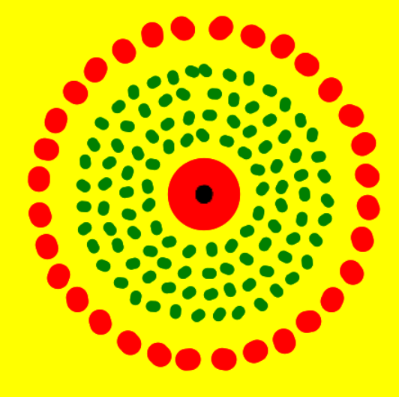For a clearer explanation go to dotted circles revisited.
A good app IMHO. Here are some sample art works I made with my dotted_circles app. The first two are me just playing around but the bottom two are attemps to imitate a portion of aboriginal art from the exhibition book referenced at the end.
This resembles a small portion of a work by Charlie Wartuma Tjungurrayl,titled Untitled, 1985, from p. 2 (reference below)
This resembles a small portion of a work by Johny Yungut Tjupurrula, Untitled, 2011, from p. 63 (reference below)
Go to the Snap! app dotted_circles_6 and do one yourself! [but read the update below first!]
Update July 2021: First up, you have to enable JavaScript extensions. Click on the Settings icon and tick the box. Honestly, I'm not sure why this is necessary. I've looked in the Snap Forum for an explanation. Brian Harvey (bh) insisted here it should not be turned on automatically as a general principle without explaining why.
The User Interface is hard to follow on dotted_circles_6. This is because I gave the user more control in an attempt to more closely imitate aspects of Papunya Tula art works. What I now suggest is go first to dotted circles revisited.
By the way, if you are curious about how the new blocks were made in Snap! then right click > edit on them. You will see that dot_number = 2*pi*inner_radius / dot_spacing, mmm... inner_radius should have been called current_radius. So the dot_number is worked out for each new circle as the radius expands. Snap! used to be called Build Your Own Blocks, which is one of its great strengths.
/Update
Reference:
unique perspectives:PAPUNYA TULA ARTISTS AND THE ALICE SPRINGS COMMUNITY (2012)
(with the last two designs I have attempted to imitate a fraction of the art work on pages 2 and 80)
Issues arising:
My overall goal is not to imitate Papunya Tula art but to find new forms to teach maths and computer coding to indigenous students.
This is an app which builds a bridge between maths and computer code to make art. When introduced to students what will the learning outcomes be? I suspect they will learn something about design but it would take a lot more input from a teacher for the students to learn computing coding and maths from this. Nevertheless, it may motivate them to do so.
The User interface is poor. Since the user has to poke around and find the values to change in the Scripting Area. Important issue but I'm not sure at this stage how to improve it. ie. you can do good art with this app but need patience to master the user interface. Not good since UI is a huge issue.
There is a big story to tell about the Papunya Tula art movement, which I have yet to tell, although others have.
The learning theory was discussed in an earlier article: Culturally Situated Design Tools: Dotted Circles Exemplar version 2. In two phrases (1) performance above representation (2) ascend to the concrete.
2025 in gaming (Nintendo)
-
Another gaming end of year recap – this time from Nintendo. I thought I was
finished with these 2025 year in reviews, with Spotify Wrapped first out of
the...
2 hours ago




No comments:
Post a Comment